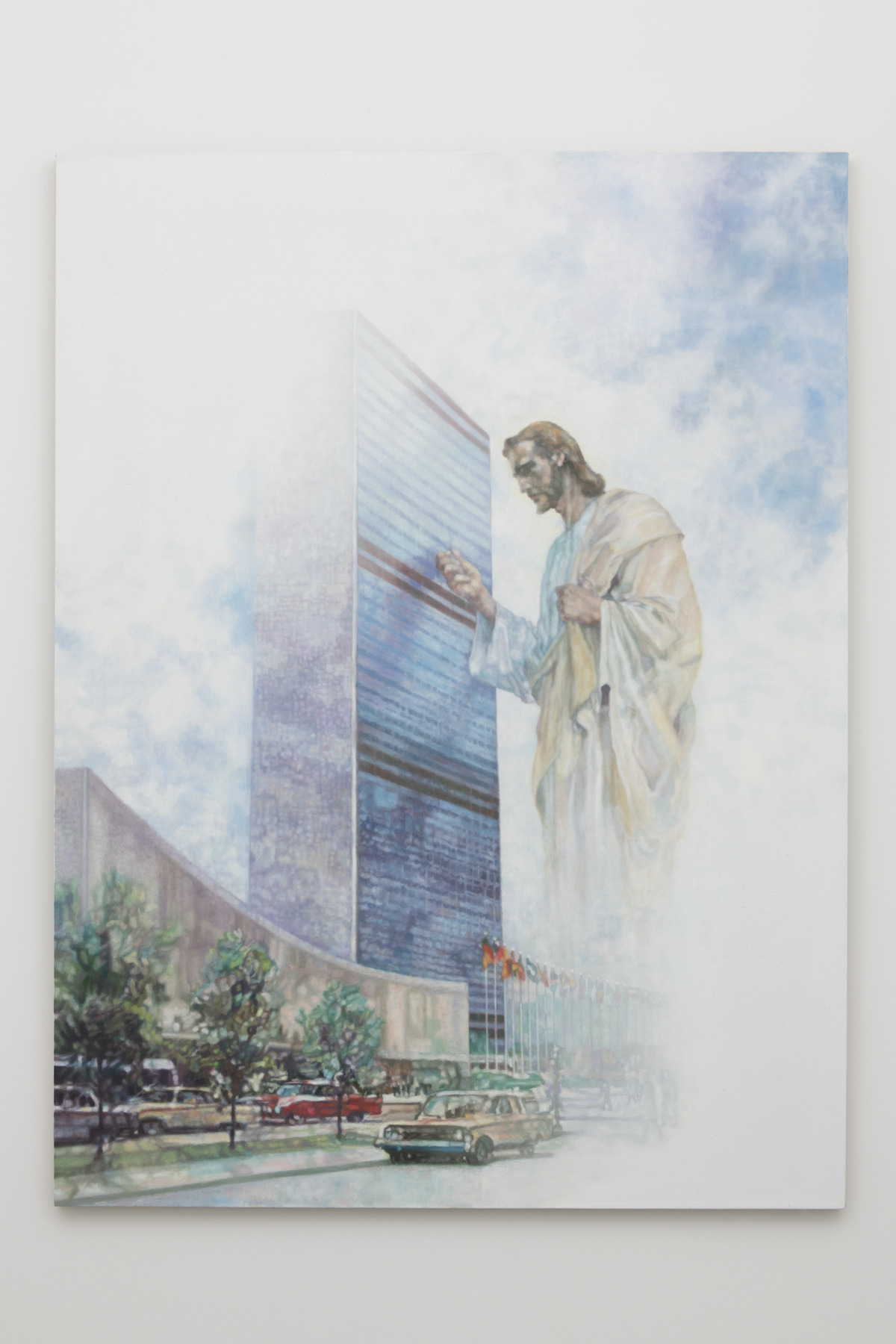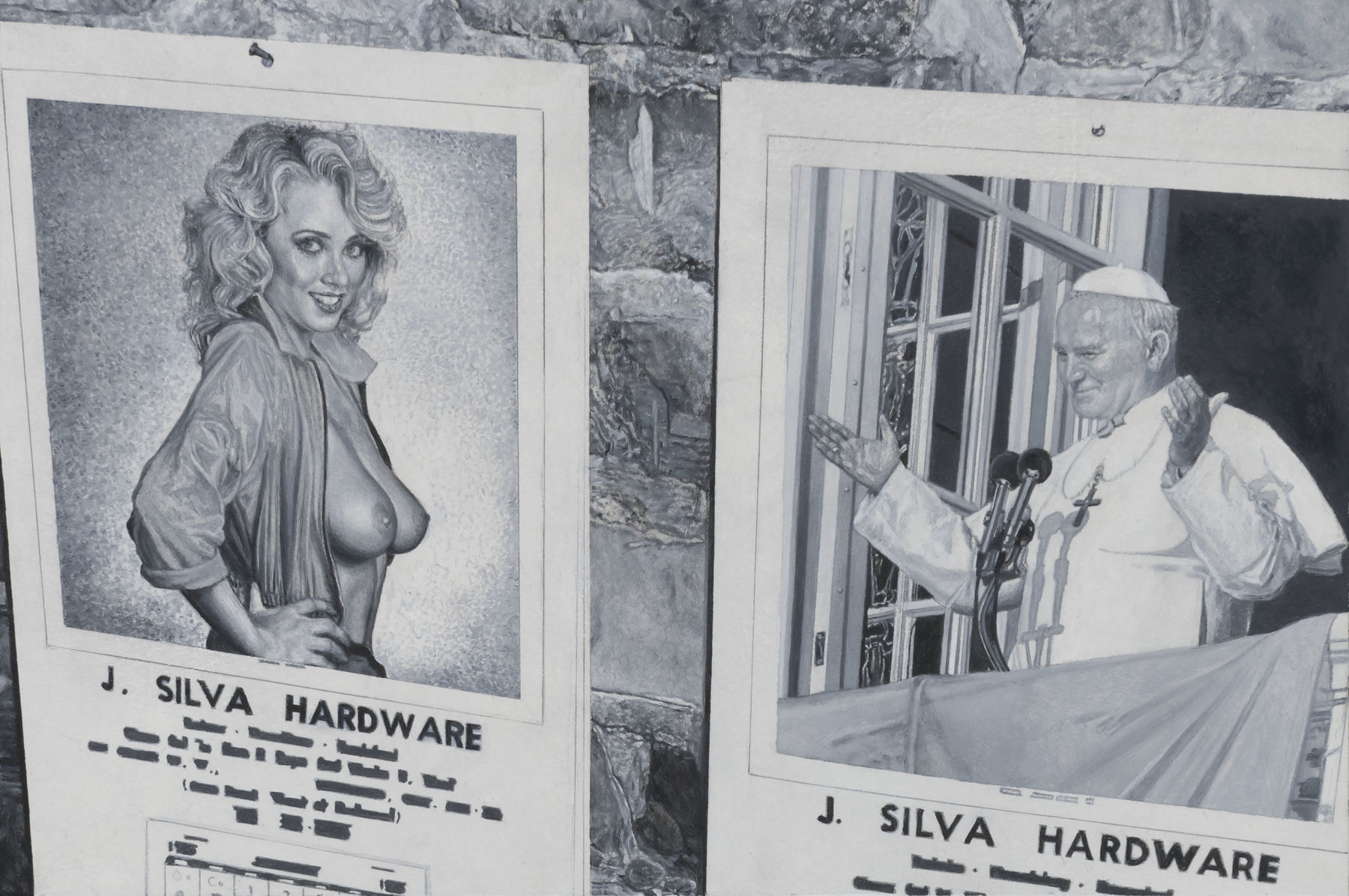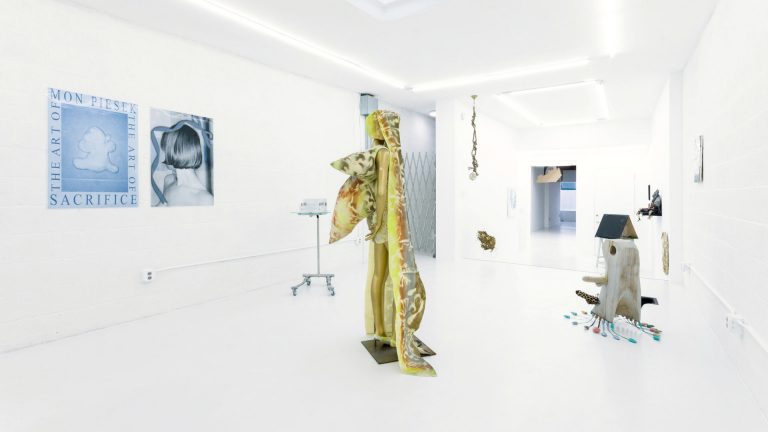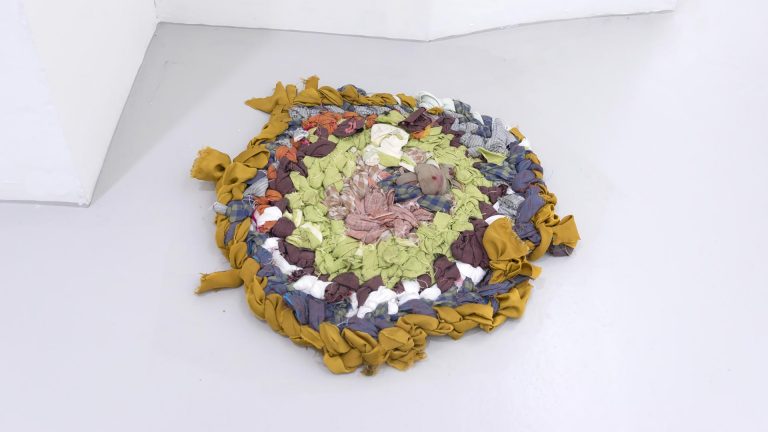Artist: Jesse Benson
Exhibition title: Miracle Grow
Venue: Michael Benevento, Los Angeles, US
Date: September 24 – November 11, 2017
Photography: all images copyright and courtesy of the artist and Michael Benevento, Los Angeles
Michael Benevento is pleased to present Miracle Grow, a solo exhibition by Los Angeles based artist Jesse Benson. Benson’s second solo exhibition with the gallery will consist of works from his ongoing series Repaintings, works from his ongoing series Dad Paintings, a specifically designed ceiling installation, and subtle gallery space alterations. Though aesthetically and stylistically diverse, the painted works all feature Benson’s mastery in rendering and complex layering of appropriated representational imagery.
The Repaintings were initiated in 2008 as an open-ended body of work involving the painstaking brushstroke-for-brushstroke hand replication of painted images found from outside the canon of Art History. Sources from professional illustration and amateur painting are discovered by Benson within situations that are sometimes relevant to the meaning of his work, and contemplation regarding the original producer also plays a role, but the uncanny, perverse, or otherwise questionable quality of the imagery itself drives the production of the Repaintings. Each chosen source painting is re-painted by Benson with at least one visual deviation from the original. For Miracle Grow Benson has arranged a specific grouping of Repaintings.
Repainting 2 (Miracle Grow) is based on the most famous image Benson has chosen for use as a Repainting. Though still outside the official canon of Art History, American professional illustrator Harry Anderson enjoyed wide public acclaim for Social Realist Americana illustration and more specifically for his contemporary Postwar Christian illustrations inspired by a connection to the Protestant denomination Seventh-Day Adventist Church. Anderson is credited with the first paintings of Christ in a Modern setting. Anderson’s depiction of a giant floating blonde Jesus knocking on the monolithic UN Building was circulated in countless prints after the image was first painted in 1961. It is an image that seems to be equally celebrated and mocked for its blunt message and skillful yet clumsy aesthetic approach. For his Repainting Benson affected the source image by enlarging it considerably, by combining effects from different warped and faded versions of the print, and by fading out two corners of the image. A relatively ubiquitous printed image at some point in certain American Protestant communities, Benson first encountered a copy at his Grandmother’s suburban Orange County home when the artist was a young child.
Repainting 5 (Prince of Peace) takes its title from the aforementioned Harry Anderson Jesus/UN Building painting but the depicted bearded white figure in Benson’s work is an oddly descript American Santa pulled from an illustration on a Christmas gift bag. The image, by an unknown illustrator, shows a closely framed rosy-cheeked Santa catching snowflakes with his glistening Santa tongue. For his Repainting Benson depicted the Santa illustration with precise commitment to the original style and palette of the source but instead of a full-bleed the borders of the image have been painted to appear specifically shaped. The resulting shape mimics a cutout snowflake, but with bilateral symmetry rather than radial, and also suggests the silhouette of a hanging ornament or of a Weihnachtspyramide. The specific shaping of the edges is open to interpretation but intentionally contains references to, among other things, razor blades, fighter jets, grenades, and the eagle design from the Great Seal of the United States.
Repainting 8 (White Man’s Burden), Repainting 9 (Orange County), and Repainting 10 (Bob Henry) are three of four related Repaintings that represent the four quadrants of a found poster split into discrete images. The poster shows a rendering of a public park with baseball fields in Orange County painted by Laguna Beach based illustrator Michael Bryan. Mr. Bryan is internationally known for flashy imagery of the aircraft, cowboy, showgirl, sports, and sports car variety, and for his work with corporate entities such as BMW, In-N-Out Burger, and the Olympics. The technique Benson employed in the making of these Repaintings mimics the transparency, puddling, and dripping effects in the original watercolor as well as the faded quality of the old printed poster. For these works Benson rendered not just the illustrated imagery of the park, but also the graphic text and corporate sponsorship logotype that accompanies the imagery on the poster. The scene shows little figures running around and enjoying Bob Henry Park, a prototypical Southern California park model in Newport Beach. Bob Henry Park is named for a police officer killed in the line of duty in 1995. In his previous exhibition with Michael Benevento, Benson’s work depicted decorative objects waiting to be hung in an FBI office. It was through that process that Benson was able to gain access to the poster, as it was décor that had been retired from the office walls.
Of the alterations to the space the most significant will be a ceiling installation work titled Chief Executive Officer. The work, composed of a single line of acoustic office ceiling tiles with embedded fluorescent lights, is designed to be installed from the ceiling against the wall directly above the running installation of Repaintings 8-10. The installation serves many functions for the exhibition, as the show’s corporate god looking down and shining light upon us, and as a synthetic reference to the untitled full-ceiling installation of acoustic tiles and lights in the storefront space where Michael Benevento was located for Benson’s previous exhibition. In that way Chief Executive Officer functions as an active document like an architectural remnant, or like a Repainting. For the purposes of the exhibition the regular circular flow of traffic between the galleries will be restricted by temporary construction that will compartmentalize the viewing experience and define movement with designed breaks between rooms and emphasized transitional spaces.
The exhibition’s final room will contain several new painted works from Benson’s series titled Dad Paintings, which interacts directly with a 1995 work by Conceptual Photographer/Labor Activist Fred Lonidier. In contrast to the Repaintings, these works by Benson appropriate a photographic canonical artwork and exist as a finite body. Lonidier’s 1995 work utilized photographs he had taken in 1983. They show a closely cropped wall scene with two calendars in the same design template, both printed for a hardware store. One is themed with topless female pinups and the other with Catholic imagery. Lonidier used the photographs of the two calendars within the design of a printed calendar-like object. Benson’s series of immaculate painted representations appear nearly identical to Lonidier’s “calendar” pages: panels sized to U.S. Letter with precise black and white photographic imagery, text, and graphics painted thinly in oil. The fonts and graphics in the sourced Lonidier work are typically Conceptual in their minimal and DIY aesthetics. Images are commonly reused in different pairings. The pages have black design layouts that reference a calendar in this context but aren’t broken up graphically into a grid of days in the month. The exception is the cover image, which shows a true calendar grid layout below a pulled-back shot of the wall.
From Organic Gardening Magazine, July/August 2000 Issue:
Miracle-Gro is a synthetic fertilizer that contains ammonium phosphate and several other chemicals that can be toxic to your soil and plants. It is prohibited from use in certified-organic farming. Here’s what soil expert Robert Parnes, Ph.D., says in his book Fertile Soil: “[Ammonium fertilizer]acidifies the soil, and thus it is probably more harmful to soil organisms than any other nitrogen fertilizer. The application has to be timed carefully and placed properly to avoid burning the leaves and roots. In addition, ammonium tends to inhibit the release of potassium. Ammonium fertilizers are deliberately manufactured to be spread at high application rates in order to obtain maximum yields with no regard to adverse effects on the soil. Probably nowhere is the conflict between the mass production of food to feed the world and the preservation of the soil more obvious than in the confrontation over the use of either ammonium fertilizers or liquid ammonia.”
Jesse Benson, Miracle Grow, 2017, exhibition view, Michael Benevento, Los Angeles
Jesse Benson, Repainting 2 (Miracle Grow), 2017, Oil on linen, 72 x 54 inches
Jesse Benson, Repainting 2 (Miracle Grow), 2017, Oil on linen, 72 x 54 inches
Jesse Benson, Repainting 2 (Miracle Grow), 2017, Oil on linen, 72 x 54 inches
Jesse Benson, Miracle Grow, 2017, exhibition view, Michael Benevento, Los Angeles
Jesse Benson, Miracle Grow, 2017, exhibition view, Michael Benevento, Los Angeles
Jesse Benson, Repainting 5 (Prince of Peace), 2017, Oil on panel in walnut frame, 20.75 x 17.75 Inches
Jesse Benson, Miracle Grow, 2017, exhibition view, Michael Benevento, Los Angeles
Jesse Benson, Miracle Grow, 2017, exhibition view, Michael Benevento, Los Angeles
Jesse Benson, Chief Executive Officer, 2017, Suspended ceiling and lights, 20 x 2 feet
Jesse Benson, Repainting 8 (White Man’s Burden), 2017, Oil on linen, 36 x 27 inches
Jesse Benson, Repainting 9 (Orange County), 2017, Oil on linen, 36 x 27 inches
Jesse Benson, Repainting10 (Bob Henry), 2017, Oil on linen, 36 x 27 inches
Jesse Benson, Miracle Grow, 2017, exhibition view, Michael Benevento, Los Angeles
Jesse Benson, Dad Painting 17, 2017, Oil on panel in aluminum frame, 11 x 8.5 inches
Jesse Benson, Dad Painting 17, 2017, Oil on panel in aluminum frame, 11 x 8.5 inches
Jesse Benson, Dad Painting 2, 2016, Oil on panel in aluminum frame, 11 x 8.5 inches
Jesse Benson, Dad Painting 2, 2016, Oil on panel in aluminum frame, 11 x 8.5 inches
Jesse Benson, Dad Painting 10, 2016, Oil on panel in aluminum frame, 11 x 8.5 inches
Jesse Benson, Dad Painting 10, 2016, Oil on panel in aluminum frame, 11 x 8.5 inches
Jesse Benson, Dad Painting13, 2016, Oil on panel in aluminum frame, 11 x 8.5 inches
Jesse Benson, Dad Painting13, 2016, Oil on panel in aluminum frame, 11 x 8.5 inches
Jesse Benson, Dad Painting 8, 2016, Oil on panel in aluminum frame, 11 x 8.5 inches
Jesse Benson, Dad Painting 8, 2016, Oil on panel in aluminum frame, 11 x 8.5 inches






























